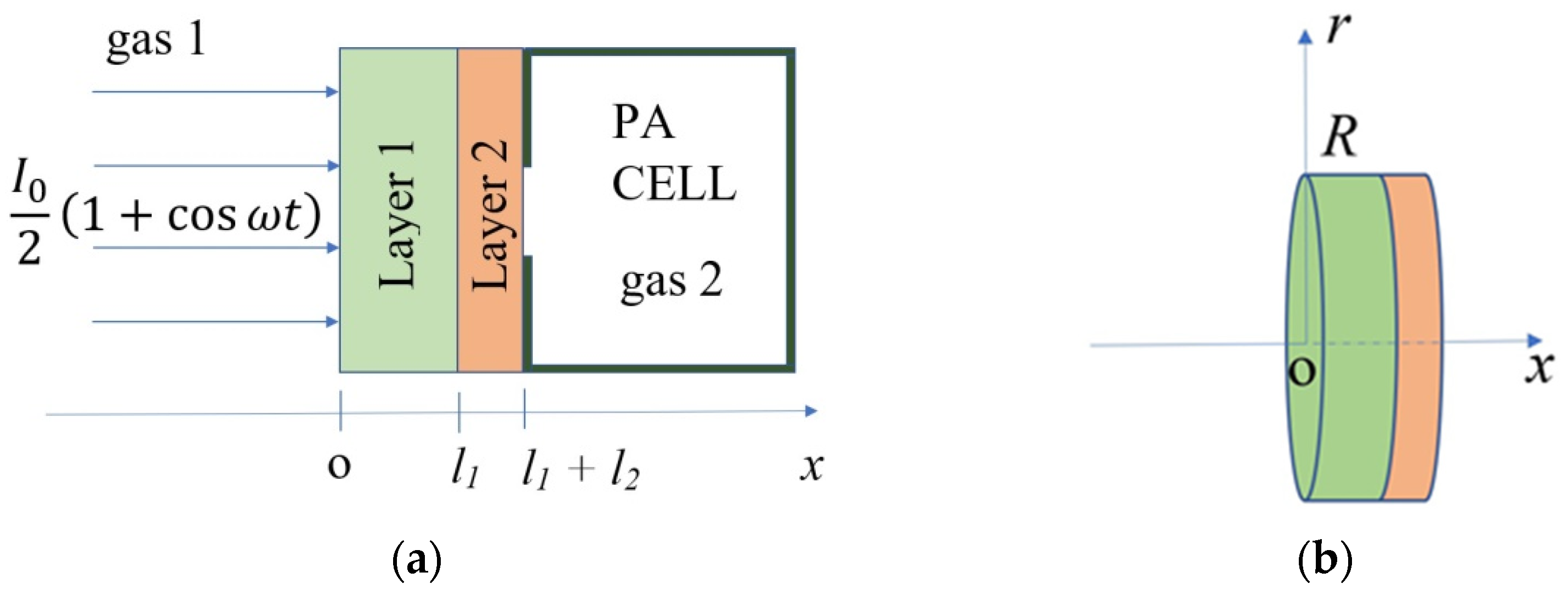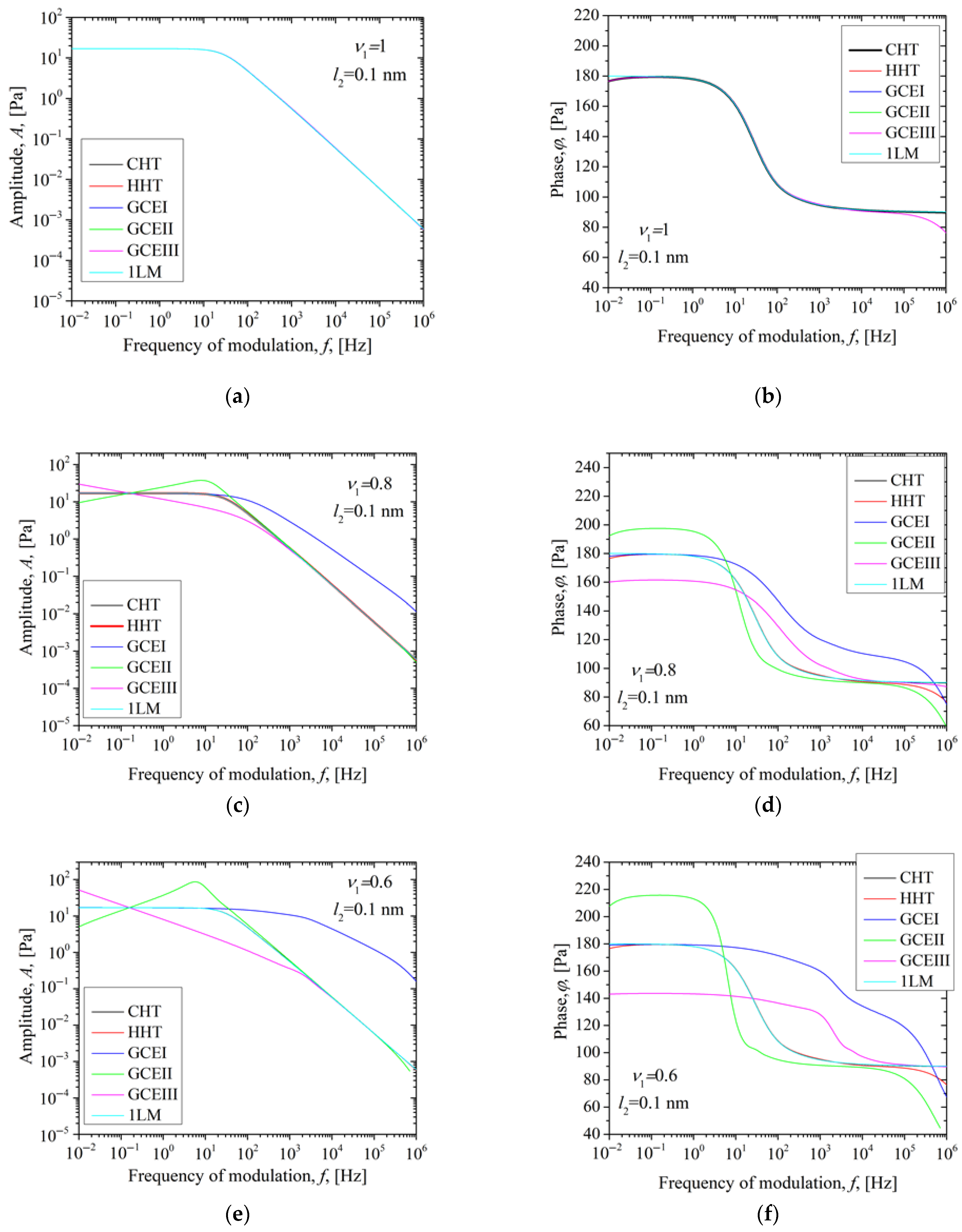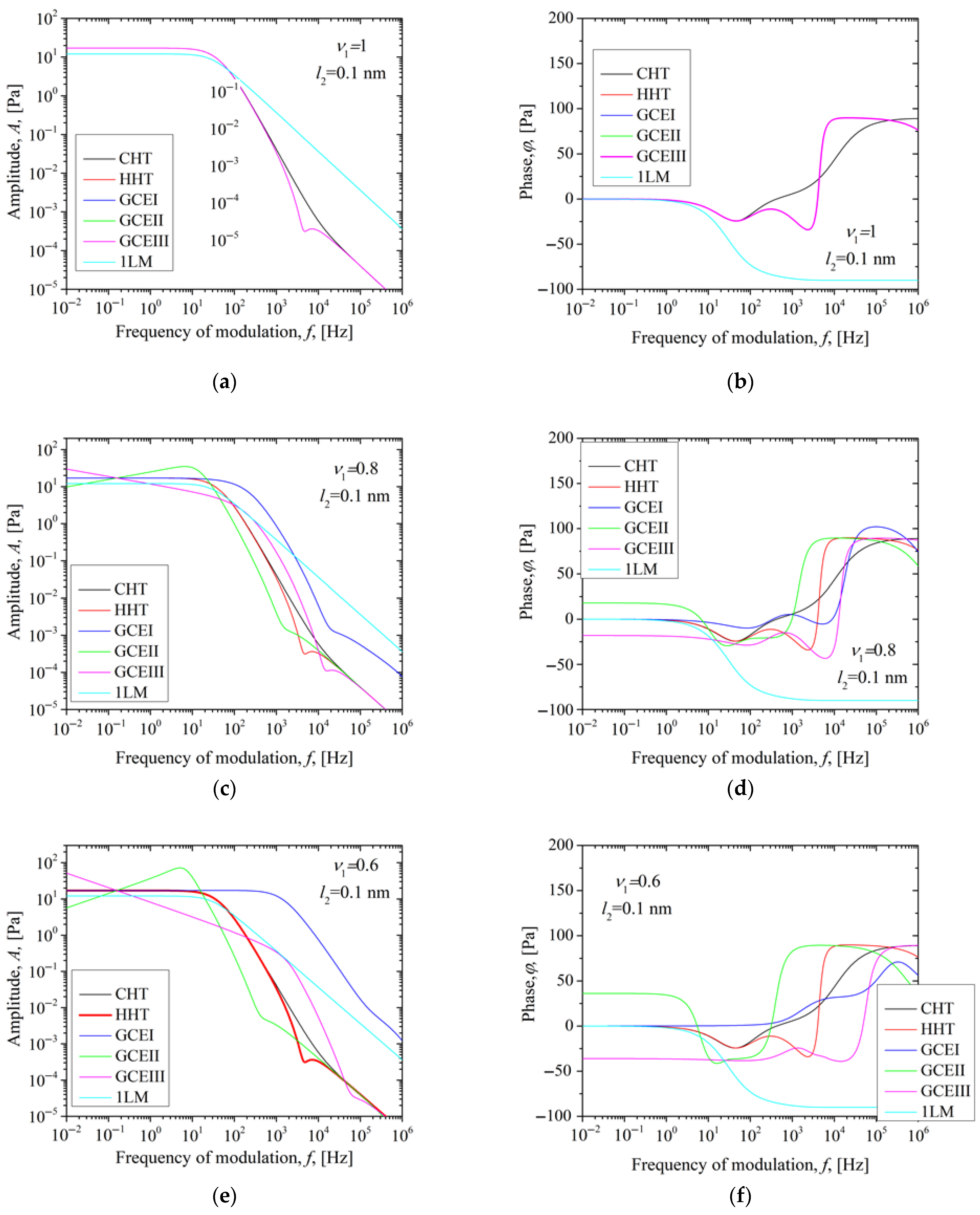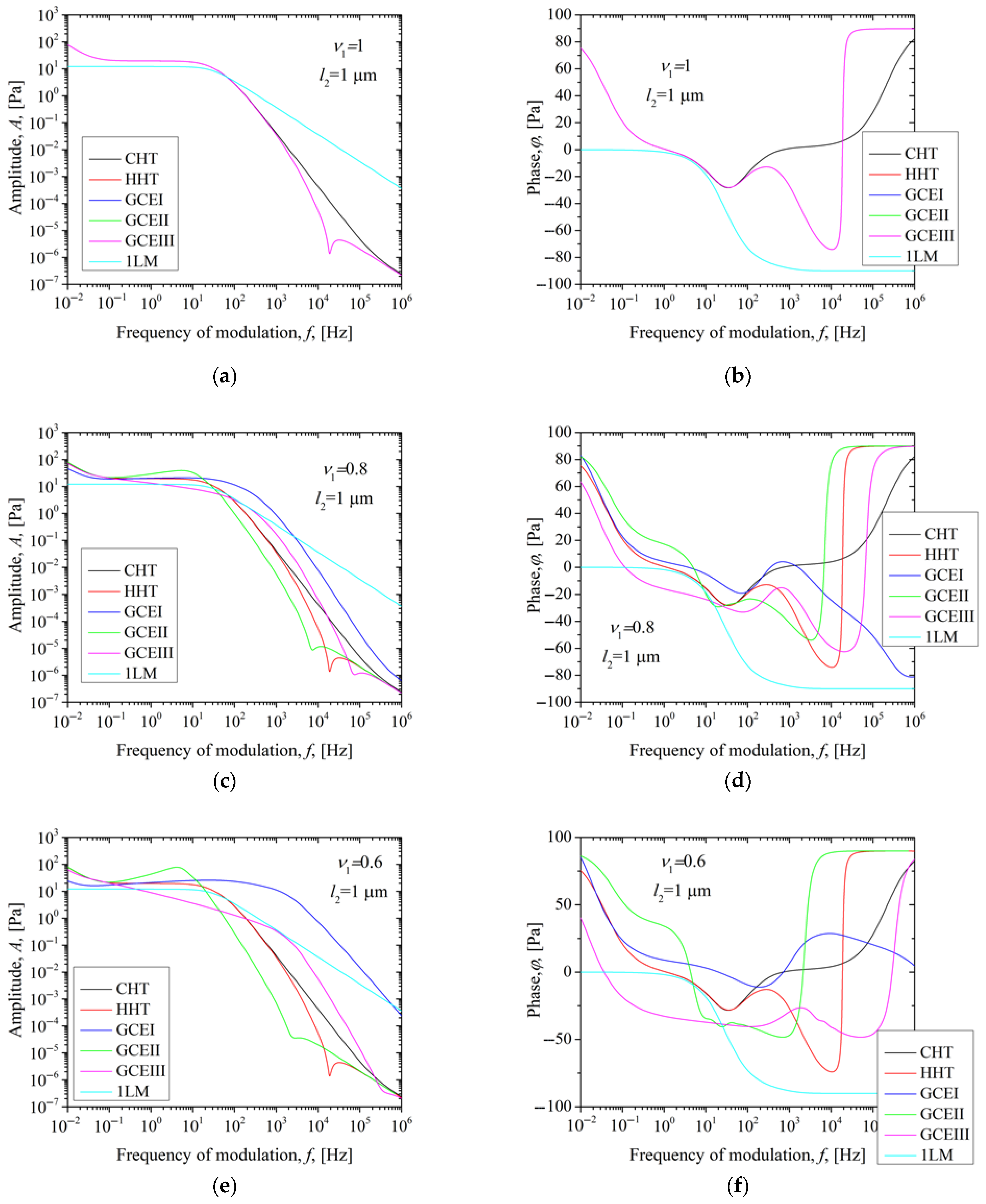The Thermoelastic Component of the Photoacoustic Response in a 3D-Printed Polyamide Coated with Pigment Dye: A Two-Layer Model Incorporating Fractional Heat Conduction Theories
Abstract
1. Introduction
2. Theory
2.1. Fractional Thermal Diffusion
2.2. Temperature Variations
- One-dimensional spatial approximation: The sample is uniformly illuminated over its surface, and the lateral dimensions are significantly larger than the thermal diffusion length in the modulation frequency range. This justifies the use of a one-dimensional geometry along the axis perpendicular to the surface, as commonly employed in photoacoustic modeling [8,9,15,70].
- Sinusoidal optical modulation and lock-in detection: The excitation source is modulated sinusoidally in time, and the resulting acoustic signal is recorded using a lock-in amplifier. Consequently, all physical quantities of interest—such as temperature, displacement, and pressure—are represented in the frequency domain using their spectral counterparts.
- Volumetric optical absorption in both layers, as opposed to the more commonly assumed surface absorption scenario [17,71,72,73,74]. This extension is crucial for describing polymeric or composite materials with structural disorder. The absorbed irradiance is calculated using Beer–Lambert’s law of absorption, , where I0 is the incident radiation’s peak intensity in [W/m2], is the optical absorption coefficient in [1/m], and is the optical reflection coefficient.
- The absence of absorption and heat conduction in the surrounding gas—Air is regarded as completely transparent, meaning it does not absorb incoming optical radiation and, as a result, does not generate heat sources. This property enables all incoming radiation to reach the first layer. Additionally, air is known to be a poor conductor of heat, which is why we apply adiabatic boundary conditions [18,69].
- The incorporation of anomalous diffusion effects via generalized Cattaneo equation (GCE) models—specifically GCEI, GCEII, and GCEIII—which allow for structural heterogeneity and memory effects in heat transport, both of which are relevant in polymeric systems with high entropy and fractal structures [17,37,39,40,64,76].
2.3. Thermoelastic Bending Effect
- It is considered that the circular plate is simply supported.
- A two-layer model utilizing generalized heat conduction theories with an infinite optical absorption coefficient for the first layer [17]—corresponding to in our model. This model was developed to describe optically opaque bilayer structures, which commonly arise in photoacoustic investigations of materials with high reflectivity. In such cases, a thin coating is applied to the sample surface to reduce optical reflection, and the sample is oriented during measurement so that the coating is illuminated. This coating typically has a very high optical absorption coefficient, ensuring that the entire incident electromagnetic energy is absorbed within a very thin surface layer—effectively at the very surface of the sample—since the optical absorption parameter .
- A two-layer model based on classical heat conduction theory for opaque layers [16]—aligning with and in our model. Similarly to the previous case, this model was developed for optically opaque bilayer samples, in which the illuminated layer exhibits a very high optical absorption coefficient, such that . However, in contrast to the previously described model, the classical model A Priori neglects the possible presence of anomalous diffusion effects and the finite speed of heat propagation.
- A single-layer model from hyperbolic heat conduction theory, that incorporates volumetric absorption of incident radiation and a coating on the unilluminated side (the microphone side) [22]—corresponding to and in the derived model. This model was developed to enable photoacoustic measurements of optically transparent or semi-transparent samples in a way that allows the determination of the sample’s optical absorption coefficient, regardless of how low it may be. In such cases, a thin coating with a very high optical absorption coefficient is applied to the transparent or semi-transparent sample, and the measurement configuration is such that this highly absorbing coating is illuminated. In this model, the possible presence of anomalous thermal diffusion in the optically transparent layer is neglected, as is the contribution of heat conduction through the coating, i.e., the coating is considered solely as an optical layer.
3. Results
3.1. Analysis of Anomalous Diffusion Effects
3.2. Thermoelastic Component of Photoacoustic Signal for PA12 Coated Sample
3.2.1. The Influence of the Order of the Fractional Derivative of a Transparent PA12 Sample and the Coating Thickness on the Thermoelastic Component
3.2.2. The Influence of the Order of the Fractional Derivative of a Whitish PA12 Sample and the Coating Thickness on the Thermoelastic Component
4. Conclusions
Author Contributions
Funding
Data Availability Statement
Conflicts of Interest
Abbreviations
| GCE | Generalized Cattaneo Equation |
| 3D- | Three-Dimensional |
| FDM | Fused Deposition Modeling |
| SLA | Stereolithography |
| SLS | Selective Laser Sintering |
| TE | Thermoelastic |
| CTRW | Continuous-Time Random Walk |
| CHT | Classical Heat Theory |
| HHT | Hyperbolic Heat Theory |
| 1LM | One-Layer Model |
References
- Formlabs Professional 3D Printers. Available online: https://formlabs.com/global/3d-printers/catalog/ (accessed on 20 May 2025).
- Polyamide (PA): Structure, Properties, and 3D Printing Applications. Available online: Https://www.sculpteo.com/en/3d-learning-hub/3d-printing-materials-guide/polyamide-pa-structure-properties-and-3d-printing-applications/ (accessed on 20 May 2025).
- Mamo, H.B.; Adamiak, M.; Kunwar, A. 3D printed biomedical devices and their applications: A review on state-of-the-art technologies, existing challenges, and future perspectives. J. Mech. Behav. Biomed. Mater. 2023, 143, 105930. [Google Scholar] [CrossRef] [PubMed]
- Kohutiar, M.; Kakošová, L.; Krbata, M.; Janík, R.; Fekiač, J.J.; Breznická, A.; Eckert, M.; Mikuš, P.; Timárová, Ľ. Comprehensive Review: Technological Approaches, Properties, and Applications of Pure and Reinforced Polyamide 6 (PA6) and Polyamide 12 (PA12). Compos. Mater. Polym. 2025, 17, 442. [Google Scholar] [CrossRef]
- Vargas, H.; Miranda, L.C.M. Photoacoustic and related photothermal techniques. Phys. Rep. 1988, 161, 43–101. [Google Scholar] [CrossRef]
- Bialkowski, S.E.; Astrath, N.G.C.; Proskurnin, M.A. Photothermal Spectroscopy Methods; John Wiley & Sons: Hoboken, NJ, USA, 2019. [Google Scholar]
- Bertolotti, M.; Li Voti, R. A note on the history of photoacoustic, thermal lensing, and photothermal deflection techniques. J. Appl. Phys. 2020, 128, 230901. [Google Scholar] [CrossRef]
- Rosencwaig, A.; Gersho, A. Theory of the photoacoustic effect with solids. J. Appl. Phys. 1976, 47, 64–69. [Google Scholar] [CrossRef]
- Rousset, L.B.G.; Lepoutre, F. Influence of thermoelastic bending on photoacoustic experiments related to measurements of thermal diffusivity of metals. J. Appl. Phys. 1983, 54, 2383–2391. [Google Scholar] [CrossRef]
- Tam, A.C. Photothermal techniques in material characterization applications. In Review of Progress in Quantitative Nondestructive Evaluation, 1st ed.; Thompson, D.O., Chimenti, D.E., Eds.; Springer: Boston, MA, USA, 1989; Volume 1, pp. 473–487. [Google Scholar]
- Tam, A.C. Applications of PA sensing techniques. Rev. Mod. Phys. 1986, 58, 381. [Google Scholar] [CrossRef]
- McDonald, F.A. Practical quantitative theory of photoacoustic pulse generation. Appl. Phys. Lett. 1989, 54, 1504–1506. [Google Scholar] [CrossRef]
- Perondi, L.F.; Miranda, L.C.M. Minimal-volume photoacoustic cell measurement of thermal diffusivity: Effect of the thermoelastic sample bending. J. Appl. Phys. 1987, 62, 2955–2959. [Google Scholar] [CrossRef]
- Medina, J.; Gurevich, Y.U.G.; Logvinov, G.N.; Guez, P.R. Photoacoustic investigation of the effective diffusivity of two-layer. Mol. Phys. 2002, 100, 3133–3138. [Google Scholar] [CrossRef]
- Gurevich, Y.G.; Logvinov, G.N.; de la Cruz, G.G.; Espejo López, G. Physics of thermal waves in homogeneous and inhomogeneous (two-layer) samples. Int. J. Therm. Sci. 2003, 42, 63–69. [Google Scholar] [CrossRef]
- Pichardo-Molina, J.L.; Alvarado-Gil, J.J. Heat diffusion and thermoelastic vibration influence on the signal of an open photoacoustic cell for two layer systems. J. Appl. Phys. 2004, 95, 6450–6456. [Google Scholar] [CrossRef]
- Somer, A.; Popovic, M.N.; da Cruz, G.K.; Novatski, A.; Lenzi, E.K.; Djordjevic, K.; Galovic, S. Photoacoustic Signal of Optically Opaque Two-Layer Samples: Influence of Anomalous Thermal Diffusion. Int. J. Thermophys. 2025, 46, 84. [Google Scholar] [CrossRef]
- Popovic, M.N.; Markushev, D.D.; Nesic, M.V.; Jordovic-Pavlovic, M.I.; Galovic, S.P. Optically induced temperature variations in a two-layer volume absorber including thermal memory effects. J. Appl. Phys. 2021, 129, 015104. [Google Scholar] [CrossRef]
- Popović, M. Generalizovani Fotoakustični odziv Dvoslojnih Struktura; Zadužbina Andrejević: Beograd, Serbia, 2019. [Google Scholar]
- Evangelista, L.R.; Lenzi, E.K. Fractional Diffusion Equations and Anomalous Diffusion; Cambridge University Press: Cambridge, UK, 2018. [Google Scholar]
- Somer, A.; Novatski, A.; Serbena, F.C.; Lenzi, E.K. Interplay between super and subdiffusive behaviors in photothermal phenomena. Int. J. Therm. Sci. 2021, 159, 106539. [Google Scholar] [CrossRef]
- Popovic, M.N.; Milicevic, D.; Kostic, L.T.; Miletic, V.V.; Galovic, S.P. Influence of the high absorbing nonilluminated surface of the sample on the photothermally induced thermoelastic bending. Int. J. Therm. Sci. 2025, 211, 109689. [Google Scholar] [CrossRef]
- Hilfer, R. Fractional diffusion based on Riemann-Liouville fractional derivatives. J. Phys. Chem. B 2000, 104, 3914–3917. [Google Scholar] [CrossRef]
- Cesarone, F.; Caputo, M.; Cametti, C. Memory formalism in the passive diffusion across highly heterogeneous systems. J. Memb. Sci. 2005, 250, 79–84. [Google Scholar] [CrossRef]
- Čukić, M.; Galovic, S. Mathematical modeling of anomalous diffusive behavior in transdermal drug-delivery including time-delayed flux concept. Chaos Solitons Fractals 2023, 172, 113584. [Google Scholar] [CrossRef]
- Metzler, R.; Rajyaguru, A.; Berkowitz, B. Modelling anomalous diffusion in semi-infinite disordered systems and porous media. New J. Phys. 2022, 24, 123004. [Google Scholar] [CrossRef]
- Metzler, R.; Jeon, J.H.; Cherstvy, A.G.; Barkai, E. Anomalous diffusion models and their properties: Non-stationarity, non-ergodicity, and ageing at the centenary of single particle tracking. Phys. Chem. Chem. Phys. 2014, 16, 24128–24164. [Google Scholar] [CrossRef] [PubMed]
- Metzler, R.; Jeon, J.H.; Cherstvy, A.G. Non-Brownian diffusion in lipid membranes: Experiments and simulations. Biochim. Biophys. Acta-Biomembr. 2016, 1858, 2451–2467. [Google Scholar] [CrossRef] [PubMed]
- Wu, H.; Schwartz, D.K. Nanoparticle tracking to probe transport in porous media. Acc. Chem. Res. 2020, 53, 2130–2139. [Google Scholar] [CrossRef]
- Höfling, F.; Franosch, T. Anomalous transport in the crowded world of biological cells. Rep. Prog. Phys. 2013, 76, 046602. [Google Scholar] [CrossRef]
- Zagato, E.; Forier, K.; Martens, T.; Neyts, K.; Demeester, J.; De Smedt, S.; Remaut, K.; Braeckmans, K. Single-particle tracking for studying nanomaterial dynamics: Applications and fundamentals in drug delivery. Nanomedicine 2014, 9, 913–927. [Google Scholar] [CrossRef] [PubMed]
- Koh, Y.R.; Shirazi-HD, M.; Vermeersch, B.; Mohammed, A.M.S.; Shao, J.; Pernot, G.; Bahk, J.-H.; Manfra, M.J.; Shakouri, A. Quasi-ballistic thermal transport in Al0.1Ga0.9N thin film semiconductors. Appl. Phys. Lett. 2016, 109, 243107. [Google Scholar] [CrossRef]
- Vlahos, L.; Isliker, H.; May, C.D. Normal and anomalous diffusion: A tutorial. arXiv 2024, arXiv:0805.0419. [Google Scholar]
- Chen, W.; Sun, H.; Zhang, X.; Korošak, D. Anomalous diffusion modeling by fractal and fractional derivatives. Comput. Math. Appl. 2010, 59, 1754–1758. [Google Scholar] [CrossRef]
- Meerschaert, M.M.; Scheffler, H. Limit theorems for continuous-time random walks with infinite mean waiting times. J. Appl. Probab. 2004, 41, 623–638. [Google Scholar] [CrossRef]
- Korabel, N.; Klages, R.; Chechkin, A.V.; Sokolov, I.M.; Gonchar, V.Y. Fractal properties of anomalous diffusion in intermittent maps. Phys. Rev. E 2007, 75, 036213. [Google Scholar] [CrossRef]
- Galovic, S.; Djordjevic, A.I.; Kovacevic, B.Z.; Djordjevic, K.L.; Chevizovich, D. Influence of local thermodynamic non-equilibrium to photothermally induced acoustic response of complex systems. Fractal Fract. 2024, 8, 399. [Google Scholar] [CrossRef]
- Meerschaert, M.M. Fractional Calculus, Anomalous Diffusion, and Probability; Chapter 11; World Scientific Publishing Co. Pte. Ltd.: Singapore, 2011. [Google Scholar]
- Compte, A.; Metzler, R. The generalized Cattaneo equation for the description of anomalous transport processes. J. Phys. A Math. Gen. 1997, 30, 7277–7289. [Google Scholar] [CrossRef]
- Galovic, S.; Čukić, M.; Chevizovich, D. Inertial memory effects in molecular transport across nanoporous membranes. Membranes 2025, 15, 11. [Google Scholar] [CrossRef]
- Metzler, R.; Klafter, J. The random walk’s guide to anomalous diffusion: A fractional dynamics approach. Phys. Rep. 2000, 339, 1–77. [Google Scholar] [CrossRef]
- Joseph, D.D.; Preziosi, L. Addendum to the paper ‘Heat waves’. Rev. Mod. Phys. 1989, 62, 375–391. [Google Scholar] [CrossRef]
- Ozisik, M.N.; Tzou, D.Y. On the wave theory in heat conduction. J. Heat Transfer 1994, 116, 526–535. [Google Scholar] [CrossRef]
- Zhukovsky, K. Operational approach and solutions of hyperbolic heat conduction equations. Axioms 2016, 5, 28. [Google Scholar] [CrossRef]
- Novikov, I.A. Harmonic thermal waves in materials with thermal memory. J. Appl. Phys. 1997, 81, 1067–1072. [Google Scholar] [CrossRef]
- Galović, S.; Kostoski, D. Photothermal wave propagation in media with thermal memory. J. Appl. Phys. 2003, 93, 3063–3070. [Google Scholar] [CrossRef]
- Novikov, I.A. Resonant generation of harmonic thermal waves in media with memory. J. Eng. Phys. Thermophys. 1992, 62, 367–372. [Google Scholar] [CrossRef]
- Jou, D.; Lebon, G. Extended irreversible thermodynamics. Rep. Prog. Phys. 1999, 51, 1105–1179. [Google Scholar] [CrossRef]
- Peshkov, V.P. Second sound in helium II. J. Phys. 1944, 8, 381–389. [Google Scholar]
- Landau, L. Theory of the superfluidity of helium II. Phys. Rev. 1941, 60, 356–358. [Google Scholar] [CrossRef]
- Jackson, T.H.; Walker, C.; McNelly, T.F. Second sound in NaF. Phys. Rev. Lett. 1970, 25, 26–28. [Google Scholar] [CrossRef]
- Narayanamurti, V.; Dynes, R.C. Observation of second sound in bismuth. Phys. Rev. Lett. 1972, 28, 1461–1465. [Google Scholar] [CrossRef]
- Kirsanov, Y.A.; Kirsanov, A.Y.; Yudakhin, A.E. Measurement of thermal relaxation and temperature damping time in a solid. High Temp. 2017, 55, 114–119. [Google Scholar] [CrossRef]
- Sobolev, S.L. Local non-equilibrium transport models. Phys. Usp. 1997, 40, 1043–1053. [Google Scholar] [CrossRef]
- Sobolev, S.L.; Dai, W. Heat transport on ultrashort time and space scales in nanosized systems: Diffusive or wave-like? Materials 2022, 15, 4287. [Google Scholar] [CrossRef]
- Garden, J. Macroscopic non-equilibrium thermodynamics in dynamic calorimetry. Thermochim. Acta 2007, 452, 85–105. [Google Scholar] [CrossRef]
- Huberman, S.; Duncan, R.A.; Chen, K.; Song, B.; Chiloyan, V.; Ding, Z.; Maznev, A.A.; Chen, G.; Nelson, K.A. Observation of second sound in graphite at temperatures above 100 K. Science 2019, 364, 375–379. [Google Scholar] [CrossRef]
- Mitra, A.V.; Kumar, S.K.; Mitra, M.K. Experimental evidence of hyperbolic heat conduction in processed meat. J. Heat Transf. 1995, 117, 568–573. [Google Scholar] [CrossRef]
- Cattaneo, C. Sur une forme de l’equation de la chaleur eliminant la paradoxe d’une propagation instantanée. Compt. Rendu 1958, 247, 431–433. [Google Scholar]
- Vernotte, P. Sur quelques complications possibles dans les phénomènes de conduction de la chaleur. Compt. Rendus Hebd. Séances Acad. Sci. 1961, 252, 2190. [Google Scholar]
- Ding, Z.; Chen, K.; Song, B.; Shin, J.; Maznev, A.A.; Nelson, K.A.; Chen, G. Observation of second sound in graphite over 200 K. Nat. Commun. 2022, 13, 285. [Google Scholar] [CrossRef]
- Jeong, J.; Li, X.; Lee, S.; Shi, L.; Wang, Y. Transient hydrodynamic lattice cooling by picosecond laser irradiation of graphite. Phys. Rev. Lett. 2021, 127, 085901. [Google Scholar] [CrossRef] [PubMed]
- Somer, A.; Novatski, A.; Lenzi, E. Theoretical predictions for photoacoustic signal: Fractionary thermal diffusion with modulated light absorption source. Eur. Phys. J. Plus 2019, 134, 593. [Google Scholar] [CrossRef]
- Somer, A.; Popovic, M.N.; da Cruz, G.K.; Novatski, A.; Lenzi, E.K.; Galovic, S.P. Anomalous thermal diffusion in two-layer system: The temperature profile and photoacoustic signal for rear light incidence. Int. J. Therm. Sci. 2022, 179, 107661. [Google Scholar] [CrossRef]
- Kiryakova, V.S. Generalized Fractional Calculus and Applications; CRC Press: Boca Raton, FL, USA, 1993. [Google Scholar]
- Oldham, K.; Spanier, J. The Fractional Calculus: Theory and Applications of Differentiation and Integration to Arbitrary Order; Elsevier: New York, NY, USA, 1974; Volume 111. [Google Scholar]
- Podlubny, I. Fractional Differential Equations: An Introduction to Fractional Derivatives, Fractional Differential Equations, to Methods of Their Solution and Some of Their Applications; Elsevier: San Diego, CA, USA, 1998; Volume 198. [Google Scholar]
- Miletic, V.V.; Popovic, M.N.; Galovic, S.P.; Markushev, D.D.; Nesic, M.V. Photothermally induced temperature variations in a low-absorption sample via backside absorption. J. Appl. Phys. 2023, 133, 075101. [Google Scholar] [CrossRef]
- Popovic, M.N.; Nesic, M.V.; Zivanov, M.; Markushev, D.D.; Galovic, S.P. Photoacoustic response of a transmission photoacoustic configuration for two-layer samples with thermal memory. Opt. Quantum Electron. 2018, 50, 330. [Google Scholar] [CrossRef]
- Mandelis, A. Photothermal applications to the thermal analysis of solids. J. Therm. Anal. 1991, 37, 1065–1101. [Google Scholar] [CrossRef]
- Galović, S.; Šoškić, Z.; Popović, M.; Cevizović, D.; Stojanović, Z. Theory of photoacoustic effect in media with thermal memory. J. Appl. Phys. 2014, 116, 024901. [Google Scholar] [CrossRef]
- Pichardo, J.L.; Alvarado-Gil, J.J. Open photoacoustic cell determination of the thermal interface resistance in two layer systems. J. Appl. Phys. 2001, 89, 4070–4075. [Google Scholar] [CrossRef]
- Astrath, N.G.C.; Astrath, F.B.G.; Shen, J.; Lei, C.; Zhou, J.; Liu, Z.S.; Navessin, T.; Baesso, M.L.; Bento, A.C. An open-photoacoustic-cell method for thermal characterization of a two-layer system. J. Appl. Phys. 2010, 107, 043514. [Google Scholar] [CrossRef]
- Ordóñez-Miranda, J.; Alvarado-Gil, J.J. Frequency-modulated hyperbolic heat transport and effective thermal properties in layered systems. Int. J. Therm. Sci. 2010, 49, 209–217. [Google Scholar] [CrossRef]
- Lord, H.W.; Shulman, Y. A generalized dynamical theory of thermoelasticity. J. Mech. Phys. Solids 1967, 15, 299–309. [Google Scholar] [CrossRef]
- Metzler, R.; Nonnenmacher, T.F. Fractional diffusion: Exact representations of spectral functions. J. Phys. A Math. Gen. 1997, 30, 1089–1093. [Google Scholar] [CrossRef]
- Todorović, D.M.; Nikolic, P.M. Carrier transport contribution on thermoelastic and electronic deformation in semiconductors. In Progress in Semiconductors; SPIE Press: Bellingham, WA, USA, 2000; Volume 4. [Google Scholar]
- Miletic, V.; Popovic, M.; Galovic, S.; Markushev, D.; Kostic, L.; Nesic, M. Influence of non-irradiated surface optical absorber on temperature gradient induced by photothermal effect in a thin film. Facta Univ. Ser. Phys. Chem. Technol. 2022, 20, 67–77. [Google Scholar] [CrossRef]
- Tuntun Plastic. Available online: https://www.tuntunplastic.com/product/polyamide-12-material.html (accessed on 20 May 2025).
- Additive 3D. Available online: https://www.additive-3d.com/polyamide-PA12-SLS-3d-printing.html (accessed on 20 May 2025).
- NETZSCH. PA12: Polyamide 12. Available online: https://analyzing-testing.netzsch.com/en/polymers-netzsch-com/engineering-thermoplastics/pa12-polyamide-12 (accessed on 20 May 2025).
- Humphries, A.; Lister, T.S.; Wright, P.A.; Hughes, M.P. Determination of the thermal and physical properties of black tattoo ink using compound analysis. Lasers Med. Sci. 2013, 28, 1107–1112. [Google Scholar] [CrossRef]
- Zakrzewski, J.; Maliński, M.; Chrobak; Pawlak, M. Comparison of theoretical basics of microphone and piezoelectric photothermal spectroscopy of semiconductors. Int. J. Thermophys. 2017, 38, 2. [Google Scholar] [CrossRef]





Disclaimer/Publisher’s Note: The statements, opinions and data contained in all publications are solely those of the individual author(s) and contributor(s) and not of MDPI and/or the editor(s). MDPI and/or the editor(s) disclaim responsibility for any injury to people or property resulting from any ideas, methods, instructions or products referred to in the content. |
© 2025 by the authors. Licensee MDPI, Basel, Switzerland. This article is an open access article distributed under the terms and conditions of the Creative Commons Attribution (CC BY) license (https://creativecommons.org/licenses/by/4.0/).
Share and Cite
Popovic, M.N.; Galovic, S.P.; Lenzi, E.K.; Somer, A. The Thermoelastic Component of the Photoacoustic Response in a 3D-Printed Polyamide Coated with Pigment Dye: A Two-Layer Model Incorporating Fractional Heat Conduction Theories. Fractal Fract. 2025, 9, 456. https://doi.org/10.3390/fractalfract9070456
Popovic MN, Galovic SP, Lenzi EK, Somer A. The Thermoelastic Component of the Photoacoustic Response in a 3D-Printed Polyamide Coated with Pigment Dye: A Two-Layer Model Incorporating Fractional Heat Conduction Theories. Fractal and Fractional. 2025; 9(7):456. https://doi.org/10.3390/fractalfract9070456
Chicago/Turabian StylePopovic, Marica N., Slobodanka P. Galovic, Ervin K. Lenzi, and Aloisi Somer. 2025. "The Thermoelastic Component of the Photoacoustic Response in a 3D-Printed Polyamide Coated with Pigment Dye: A Two-Layer Model Incorporating Fractional Heat Conduction Theories" Fractal and Fractional 9, no. 7: 456. https://doi.org/10.3390/fractalfract9070456
APA StylePopovic, M. N., Galovic, S. P., Lenzi, E. K., & Somer, A. (2025). The Thermoelastic Component of the Photoacoustic Response in a 3D-Printed Polyamide Coated with Pigment Dye: A Two-Layer Model Incorporating Fractional Heat Conduction Theories. Fractal and Fractional, 9(7), 456. https://doi.org/10.3390/fractalfract9070456









